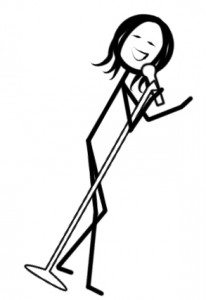7 Basic Mic Stand Techniques
by Backstage: Materials, Tools & Skills Greenroom: 6 Comments
Onstage Success - Tom Jacksons Live Music Method
Onstage with Live Music Producer Tom Jackson
 A fig leaf… or a microphone stand. Which one do you use?
A fig leaf… or a microphone stand. Which one do you use?Tom is uniquely talented and skilled at transforming an artist's live show into a magical experience for the audience; helping artists at every level create a live show that is engaging and memorable, teaching them to exceed their audiences' expectations and to create fans for life. Tom has taught indie and major artists of every genre. He has worked with Taylor Swift, Le Crae, Home Free, The Tenors, Shawn Mendes, The Band Perry, Francesca Battistelli, Jars of Clay, & many more. Tom also teaches at colleges, conferences and events worldwide.
My Associate Producer Amy Wolter doesn't know I'm sending this out but she … [Read More...]
One of the "7 Deadly Sins of an Artist" I talk about is "being good." … [Read More...]
In my previous blog geared toward guitar players, I wrote about what you … [Read More...]
Since most violin players are – as far as I know - classically trained, it … [Read More...]
As you know, the visual aspects of a performance are important, and we work … [Read More...]
I've gotten both kinds of calls — the kind where I'm asked to help an … [Read More...]
No shows booked at the moment.
Contact Us · Copyright © 2025 Tom Jackson Productions · All Rights Reserved · Log in
Iggy Pop worked the mic stand tool impressively quite often also
Thanks Tom. This gives some great ideas! I generally only use the mic stad when singing as we play plugged in, which allows me to move away from the mic and give the singer center stage (and also helps me dance around more!). I do, however, sing a couple of ballads that I may change up after reading this.
That’s great!
Great tips as always Tom! Some great examples of using the mic stand as part of the show would be Steven Tyler, Bruce Dickinson (in the early Iron Maiden days as he no longer uses the stand), and Freddie Mercury, although is “half stand” trick was so unique I wouldn’t advise it as people would think someone is jus copying him. Tom Keifer of Cinderella uses it very well also and obviously influenced by Steven Tyler
Absolutely, some great examples of creativity in this area
Glorious!